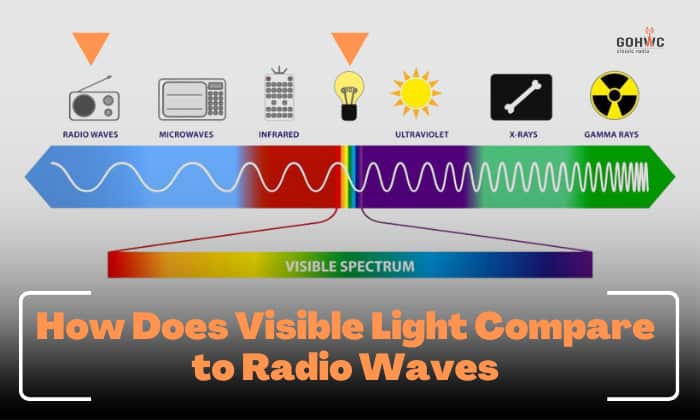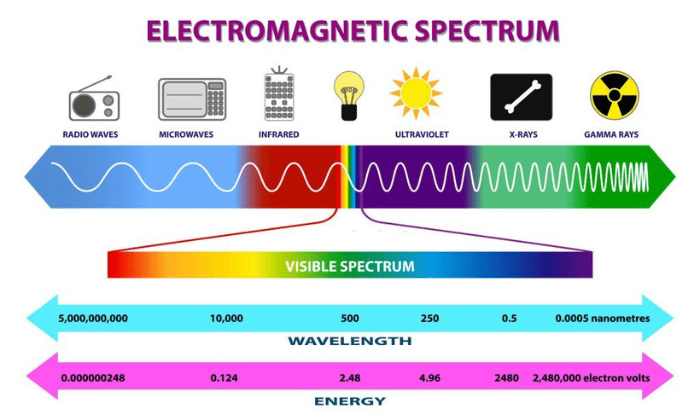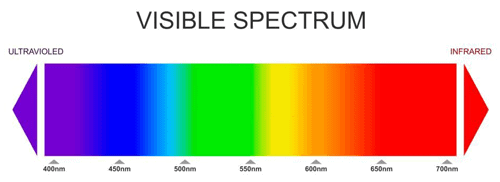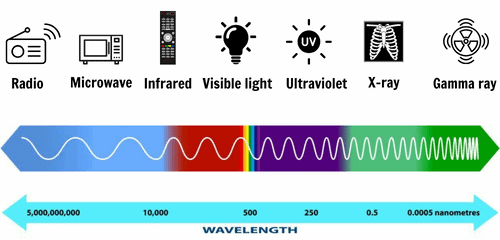If you are new to the world of radioing, to enhance your knowledge and skills in this enjoyable hobby or potentially profession, you should start by learning the basics of the electromagnetic spectrum.
The short answer to “How does visible light compare to radio waves?” is that both are part of the spectrum, and their main difference is their visibility.
As its name suggests, visible light is visible to the human eye, while radio waves are not. Whether you’re a novice or an expert, differentiating between the two and the whole spectrum is helpful in your journey as a hobbyist.
Contents
Overview
For starters, let’s quickly discuss the EM spectrum, or the range of electromagnetic radiation – on the planet and beyond. Radiation, meanwhile, is a type of energy that travels from its source and spreads through space.
Here’s the EM spectrum, sorted in order of frequency (lowest to highest; or longest to shortest wavelength):
Radio > Microwave > Infrared > Visible light > Ultraviolet > X-ray > Gamma ray
- Use for radio waves can be found in radio and television stations as well as amateur radio enthusiasts.
- Microwaves are present in microwave ovens and aircraft communication.
- Night vision goggles, remote controls, and old cell phones employ infrared.
- Visible light is seen in lighting devices like bulbs, fluorescents, neons, and such. UV light is emitted by the sun, some lighting devices, tanning beds, and some lasers.
- Just as its name implies, X-rays are present in X-ray scanners (those in laboratories and airports).
- Gamma rays are present in outer space.
Differences
1. Visibility
As mentioned, the main difference between visible light and radio waves is their visibility: the human eyes can see the previous but not the latter. Humans can detect wavelengths from 380 to 700 nanometers (nm), with visible light ranging from 400 to 700 nm.
Meanwhile, radio waves range from a centimeter to a kilometer, which is longer than visible light. Radio waves have the longest wavelengths in the EM spectrum.
Radio waves are so big that to be able to see them, humans would need to have humongous eyes. No other organisms can see radio waves, too, according to science.
2. Speed
The speed of visible light, radio waves, and others in the EM spectrum are the same. In vacuum, that’s 299,792,458 meters per second (m/s) or 3 x 108 m/s (about 186,282 miles per second). Light travels the fastest in a vacuum but slower in glass or water. In a second, light could encircle the Earth seven times.
3. Wavelength and Frequency
As mentioned, the shorter the wavelength, the higher the frequency. The frequency of radio waves falls from three kilohertz to 300 gigahertz, while visible light varies, depends depending on the color of the light.
Red light has longer wavelengths (around 620 to 750 nm), while blue and purple have shorter wavelengths (about 450 to 495 nm). Accordingly, red light has lower frequency (430 terahertz) than blue and purple light (750 THz).
4. Energy
Furthermore, the shorter the wavelength, the higher the energy. As mentioned, radiation is about energy in relation to wave propagation.
The National Aeronautics and Space Administration (NASA) explains that EM radiation can be described in terms of photons, which hold energy. Radiations are the emission of energy carried by photons.
Radio waves have the lowest energy (< 2 x 10-24 joules), while in visible light, it depends on color (from 3 x 10-19 to 5 x 10-19 J): red photons have about 1.8 electron volts (eV), while blue ones have around 3.1 eV.
Applications and Uses
So how do radio waves work? Its various frequencies are commonly utilized in television and radio broadcasting, be it amplitude or frequency modulation (AM and FM). Furthermore, it’s also present in the following applications:
- Military communications
- Cell phones
- Wireless computer networks
- Ham radios
- Shortwave radios
- Remote-controlled toys
- Air-traffic control and other types of navigation
Meanwhile, if it needs explanation, visible light has the following applications:
- Illumination
- Photography
- Fiber optic communications
- Laser
- Natural sources like sunlight and light emissions in outer space
Conclusion
Now that you have come to the end of the article, you can easily describe how does visible light compare to radio waves if a newbie radio enthusiast asks you.
Learning about this seemingly geeky information is not a must when you dabble in the world of radioing, but knowing them is a plus. Sure, it can be too much and intimidating, but it makes you a better radio user. After all, knowledge is power.

Hello! I am Hart, the content writer and editor here at G0HWC. I used to be in the same local radio club with Howe, and he convinced me to join him in spreading my love for the radio with others. With a background in radio studies, I spend every day crafting accurate, easy to read content on various topics related to owning and using radios. I hope that my content can help you confidently venture in your radio journey!





